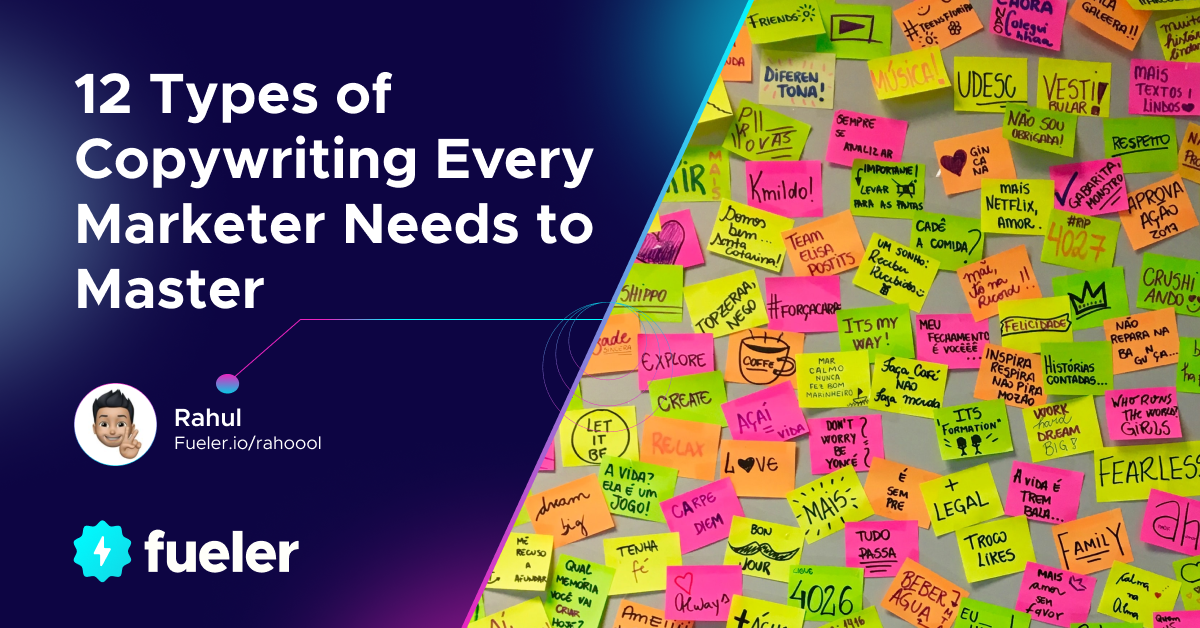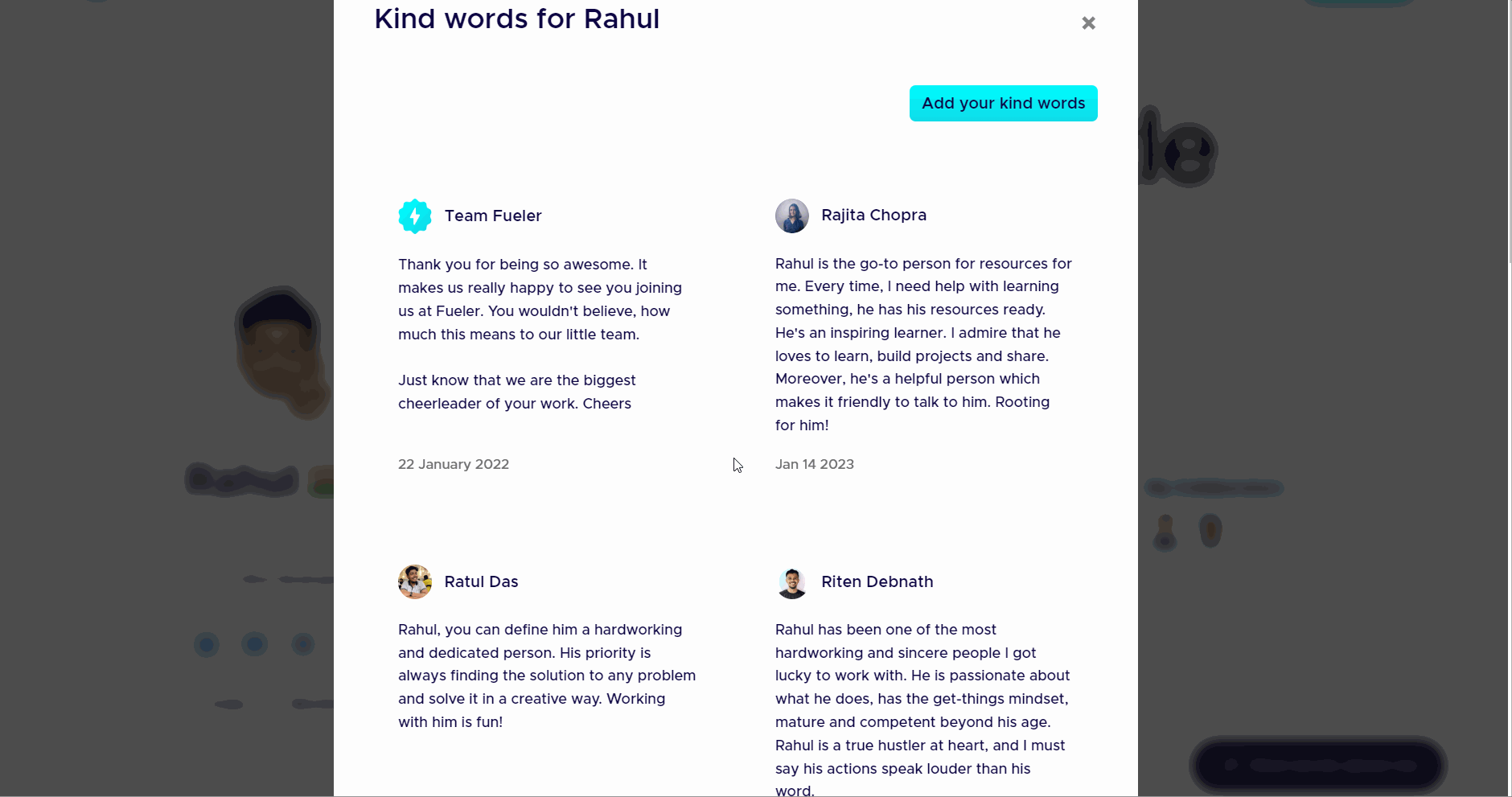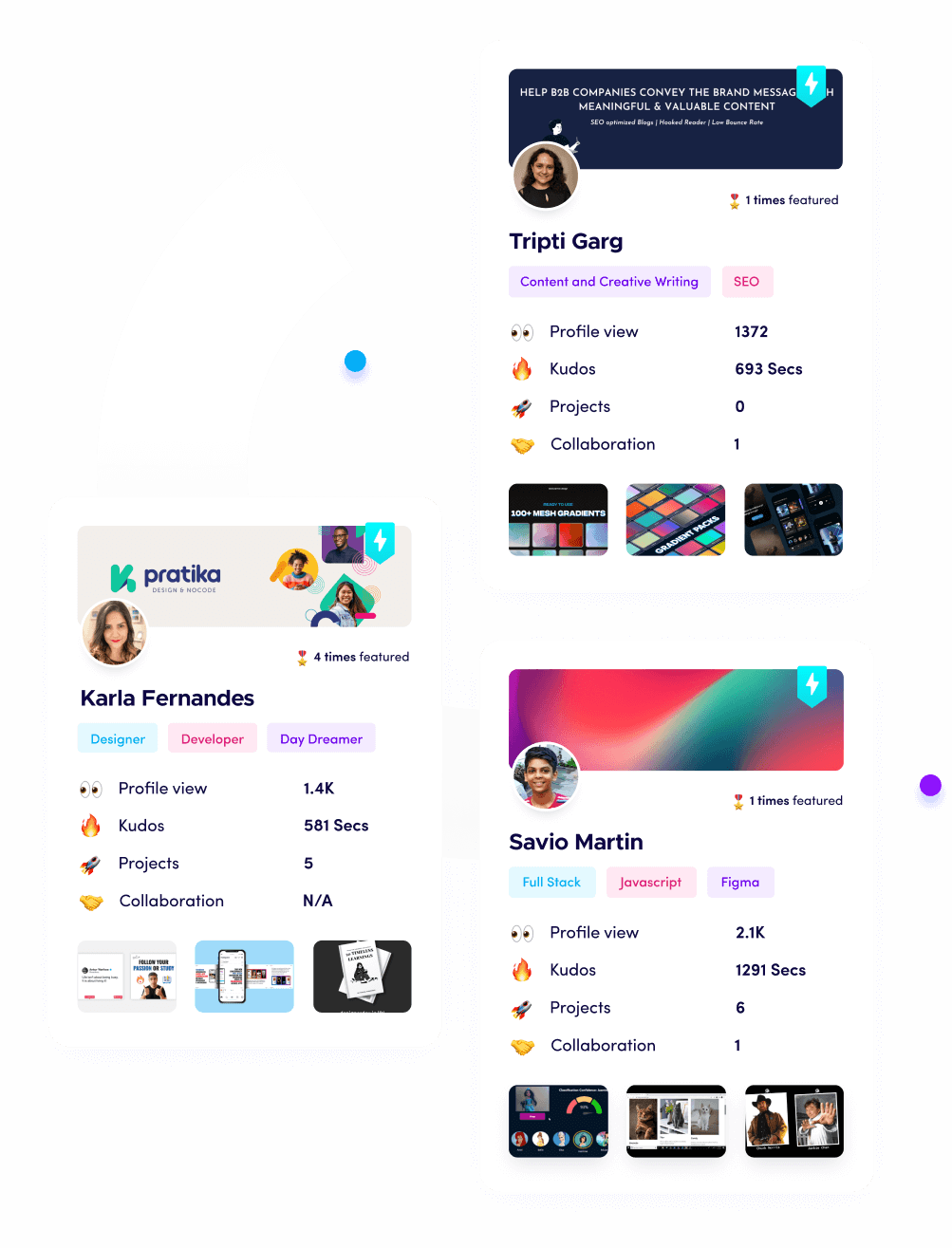12 Types of Copywriting Every Marketer Needs to Master

Team Fueler
12 Jan, 2023

As a marketer, you need to be able to write copy that sells. But what kind of copy should you be writing? And how can you make sure your portfolio stands out from the rest?
This blog post will outline the different types of copywriting that every marketer needs to master. From SEO copywriting to social media copywriting, I'll cover all the challenges and best practices for each type.
Plus, I'll give you tips on how to create a portfolio that will impress potential clients.
So whether you're just getting started in copywriting or you're looking to take your skills to the next level, read on for everything you need to know.
And when you're ready to start creating your portfolio, be sure to check out Fueler, Freelance Copywriters' first choice to create a professional-looking portfolio
What are The Different Types of Copywriting?
There are many different types of copywriting, each with its own set of challenges and best practices.
The most common copywriting niches are
- SEO copywriting,
- B2B copywriting,
- Technical copywriting,
- Web copywriting,
- Ad copywriting,
- Social media copywriting,
- Email copywriting,
- Video script copywriting,
- Whitepaper copywriting
SEO Copywriting
SEO copywriting is a specialized form of writing that helps improve a website's ranking in search engine results.
It is a complex and ever-changing field, but the basics are simple: SEO copywriting is all about creating content that is both relevant and popular.
To write effective SEO copy, you need to understand how search engines work and what people are searching for.
You also need to be able to create persuasive SEO-friendly content that encourages others to link back to your site.
Here are a few tips for writing effective SEO copy:
1. Write for your audience first
Your priority should always be to write for your target audience. What information are they looking for? What questions do they have? Write content that is helpful and informative, and make sure it is easy to read and understand.
2. Use keyword-rich titles and descriptions
Your title and meta description are important places to use keywords, as they help tell search engines what your page is about. However, don't stuff your keywords in – just use them naturally as you would in any other piece of writing.
3. Make sure your website is easy to navigate
Search engines prefer websites that are easy to navigate and understand. That means having a clear hierarchy, well-labeled links, and a sitemap. Making your website user-friendly will not only improve your ranking, but it will also encourage people to stay on your site longer.
4. Use social media to promote your content
Social media can be a great way to promote your content and get more people linking to your site. Share your articles on Twitter, Facebook, LinkedIn, and other social networks, and make it easy for people to share them with friends and followers.
B2B Copywriting
B2B copywriting is a specialized form of writing that helps promote a product or service to a business audience. It can be used to generate leads, increase sales, or simply create awareness about a company or its products and services.
One of the challenges of B2B copywriting is that businesses are often more complex than consumer-oriented businesses, with multiple decision-makers involved in the purchasing process.
This means that B2B copywriters need to be able to communicate the features and benefits of a product or service in a way that speaks to the needs of each decision-maker.
Another challenge of B2B copywriting is that businesses are often very risk-averse, so copywriters need to be able to instill confidence in potential customers by highlighting the company's experience, success stories, and guarantees.
Best practices for B2B copywriting include understanding the buyer's journey, tailoring content to each stage of the journey, using strong calls-to-action, and including testimonials and case studies.
When creating a portfolio, B2B copywriters should focus on quality over quantity, and choose a few select pieces that showcase their skills and highlight their successes.
Technical Copywriting
Technical copywriting is a specialized form of writing that requires a high degree of accuracy and precision.
In technical copywriting, you must be able to understand complex technical concepts and explain them in simple terms. This type of writing is often used in manuals, instructions, and documentation. Your goal is to make the complex seem simple and easy to understand.
Successful technical copywriting requires a few best practices. First, it's important to have a strong understanding of the technical concepts you'll be writing about. Make sure you take the time to research and understand the material before you start writing.
It's also important to use clear and concise language in your writing. Be careful not to over-explain or use jargon that your audience won't understand.
Finally, it's important to proofread your work carefully before publishing it.
Technical errors can be off-putting for readers and damage your credibility as a writer.
If you're interested in pursuing a career in technical copywriting, it's important to build up a strong portfolio of work. When choosing pieces to include, focus on quality over quantity. showcase your ability to write clearly and concisely about complex topics.
If you have any experience working with coding languages, be sure to highlight these skills as well. With a strong portfolio, you'll be well on your way to success in this field.
Technical Writer Portfolio Examples
Web Copywriting
Web copywriting is a specialized form of writing that helps promote a product or service on the internet. It is important to remember that people read web copy differently than they would read a brochure or an advertisement.
When writing web copy, it is important to keep the following tips in mind:
1. Write for your audience first
When writing web copy, it is important to think about who your target audience is and what they are looking for. It is also important to keep in mind that people tend to skim web copy, so make sure your most important information is easy to find.
2. Use keyword-rich titles and descriptions
Using keywords throughout your web copy will help improve your website's ranking in search engine results in pages. However, it is important to use keywords sparingly and naturally, as too many keywords can make your content difficult to read.
3. Make sure your website is easy to navigate
Your website should be easy for both potential customers and search engines to navigate. Creating a sitemap can help ensure that all of your pages are linked together properly.
4. Use social media to promote your content
Social media can be a great way to promote your web copy and drive traffic to your website. Posting links to your content on social media sites such as Facebook, Twitter, and LinkedIn can help increase its visibility.
Ad Copywriting
Ad copywriting is a specialized form of writing that helps create advertisements. Ad copywriters are responsible for creating the headlines, body copy, and call to action for an advertisement.
To be effective, ad copywriters must understand the needs and wants of the target audience and craft their message accordingly.
Ad copywriting is often used in conjunction with other forms of advertising, such as television or radio commercials.
There are several things that ad copywriters need to keep in mind to create effective advertisements.
First, they need to understand the needs and wants of the target audience.
What are they looking for?
What will appeal to them?
Second, ad copywriters need to write headlines that are attention-grabbing and make people want to read more.
Third, the body copy should be well-written and persuasive, without being too salesy.
Finally, the call to action should be clear and concise, and tell the reader what they need to do next.
When creating a portfolio, ad copywriters should focus on quality over quantity. They should choose a few of their best pieces and showcase them prominently.
It is also important to have a variety of different types of ads in your portfolio so that potential clients can see your range.
Copywriter Portfolio Examples
Social Media Copywriting
As the use of social media has become increasingly widespread, so needs effective social media copywriting.
Social media copywriting is a specialized form of writing that helps promote a product or service on social media platforms. To be effective, social media copywriters must understand how to use each platform's unique features to their advantage.
Additionally, they must be able to craft engaging and attention-grabbing content that speaks to the needs of the target audience.
Some tips for writing effective social media copy include,
- Understanding the platform you're using,
- Knowing your audience, and
- Creating compelling headlines.
Additionally, it's important to focus on quality over quantity and to make sure that your content is visually appealing.
Finally, you should always measure the success of your social media campaigns and adjust your strategy accordingly.
When creating a portfolio, social media copywriters should showcase a variety of their best work. This will give potential clients a sense of your range and ability to adapt to different platforms.
Additionally, it's important to include links to any successful campaigns you've worked on in order to demonstrate your effectiveness.
Email Copywriting
Email copywriting is a bit different than other types of copywriting, as you have to take into account the fact that people will be reading your email on a small screen. This means that your email should be concise and to the point, with a clear call to action.
Additionally, your subject line should be attention-grabbing and make use of keywords so that it will be more likely to be seen in a search. As with any type of copywriting, it's important to know your audience and what would appeal to them.
For email copywriting, this means keeping your language simple and your message clear.
You should also avoid using too many images, as these can be difficult to load on a mobile device. Instead, focus on creating a well-written email that will encourage your reader to take action.
A good portfolio should include a variety of email copy so that potential clients can see the range of your skills. As with any writing samples, be sure to choose your best work to showcase.
Video Script Copywriting
Video copywriting is a specialized form of writing that helps promote or sell a product or service through video. A good video copywriter understands how to use the medium of video to tell a story that engages the viewer and convinces them to take action.
There are several elements that make up a good video script.
Firstly, it is important to have a clear goal for the video. What do you want the viewer to do as a result of watching it?
Once you have established this, you can then start writing the script itself. The script should be well-written and engaging, with a strong focus on the key message that you want to communicate.
Additionally, it is important to ensure that the video is visually appealing and includes relevant images or footage.
Finally, the call to action should be clear and concise.
When used effectively, video copywriting can be an extremely powerful marketing tool. It allows you to connect with your audience on an emotional level and persuade them to take action.
To get the most out of video copywriting, it is important to understand your audience and what they are looking for.
Additionally, testing and measuring your results is crucial to improve your skills over time.
Sales Letter Copywriting
Sales letter copywriting is a specialized form of writing that helps promote a product or service through direct mail.
Sales letters are typically sent to potential customers who have been identified as likely to be interested in the product or service.
The purpose of a sales letter is to convince the recipient to take action, such as buying a product, signing up for a service, or attending an event.
In order to be effective, sales letters must be well-written and persuasive.
Additionally, they should include a strong call to action that tells the reader what they should do next.
Here are a few tips for writing effective sales letters:
1. Understand your audience
Before you start writing your sales letter, it's important to take some time to understand your target audience.
What are their needs and wants?
What objections might they have to your product or service?
By understanding your audience, you'll be able to craft a more effective sales message.
2. Write a compelling headline
Your headline is one of the most important elements of your sales letter. It should be attention-grabbing and make the reader want to learn more about what you have to offer. A good headline will also give the reader an idea of what the letter will be about.
3. Keep it focused
When writing your sales letter, it's important to keep the message focused on the reader. What can you offer them that will solve their problem or meet their needs?
Make sure every element of your letter supports this central message.
4. Use strong calls to action
Your call to action should be clear, concise, and easy to follow. Tell the reader exactly what you want them to do, such as "call now", "visit our website", or "stop by our store".
Including a sense of urgency can also help encourage people to take action.
Ghostwriting
Ghostwriting is a specialized form of writing that helps create content that sounds like it came from the client themselves.
It is important for ghostwriters to be accurate and research thoroughly, as well as go through a revision process before publication.
Want to learn more about Ghostwriting? Follow this blog post.
White Paper Copywriting
White paper copywriting is a specialized form of writing that helps promote a product or service through long-form, educational content.
White papers are often used in B2B marketing, as they are a way to build trust and credibility with potential customers. In order to be effective, white paper copywriters must understand how to use persuasive language, format the content in an easy-to-read way, and include a strong call to action.
When creating a portfolio, white paper copywriters should focus on quality over quantity. They should also showcase a variety of their best work, including any successful campaigns they've worked on.
Whitepaper Example
Google’s technical white paper
250+ page technical white paper from Microsoft
More whitepaper examples, find here
How to Create a Copywriting Portfolio that Stands Out
As a freelance copywriter, one of the best ways to showcase your skills and attract new clients is to create a portfolio, but what exactly should you include in your portfolio?
And how can you make sure it stands out from the rest?
Here are a few tips to help you create a copywriting portfolio that will help you land new clients and fuel your career:
1. Showcase Your Best Work
When it comes to your portfolio, quality trumps quantity. So, instead of filling it with every piece of copy you've ever written, take the time to curate only your best work.
Think about the types of projects you want to be working on and include examples that showcase your skills in that area. For example, if you want to write web copy, make sure to include some of your best web pages.
2. Create a Portfolio on Fueler
Fueler is the best way to showcase your work since it's easily accessible and can be shared with potential clients with just a few clicks.
Signing up for Fueler is free and only takes a few minutes. By having your work in one place, you can make it easier for clients to find and hire you.
3. Easy to Navigate
When someone visits your Fueler profile, you want them to be able to easily find the information they're looking for, right? Fueler makes that simple for you, don't trust me?
Look at this marketer profile -Anshu Shandilya
4. Use Powerful Headlines
Your headlines are important since they're often the first thing potential clients will see. So, make sure your headlines are attention-grabbing and accurately reflect the content of your portfolio pieces.
5. Use persuasive language
Remember, your portfolio is a marketing tool, so it's important to use persuasive language throughout. Use strong verbs to describe your work and don't be afraid to toot your own horn a bit.
For example, instead of saying "I wrote this web page", say "I crafted a compelling web page that increased conversions by XYZ%".
6. Use Testimonials
One of the best ways to show potential clients the value of your work is to use testimonials from past clients. If you have any glowing reviews or feedback, be sure to include them in your portfolio.
There is a section for kind words on your Fueler portfolio, where you can directly ask your client to add some feedback or just embed a tweet.
7. Keep It Up-to-Date
Your portfolio should be a living, breathing document that you regularly update with your latest and greatest work. So, make sure to add new projects as you complete them.
By following these tips, you can create a copywriting portfolio that will help you land new clients and fuel your career.
Takeaway
Thank you for reading our article on 12 Types of Copywriting Every Marketer Needs to Master.
I hope you found it informative and helpful in understanding the various types of copywriting that are essential for marketers to master.
Remember, the key to successful copywriting is understanding your audience and tailoring your message to meet their needs and interests.
Whether it's crafting compelling headlines, creating persuasive call-to-action phrases, or writing product descriptions that sell, mastering these 12 types of copywriting can help you achieve your marketing goals.
Special thanks to Rahul for creating this well-researched article, he is a Developer Advocate himself, and he loves to code, write blogs and build side projects



